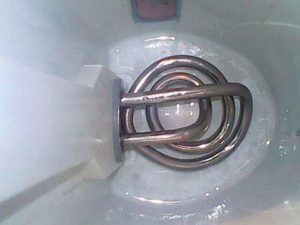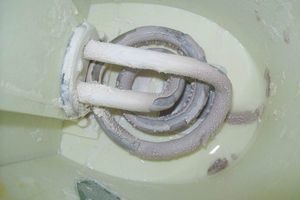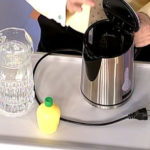Where is the spiral located in an electric kettle?
 An electric kettle has long been used by almost every housewife. It's hard to imagine even one day without tea! The kettle is easy to use and has an extremely simple operation scheme. Although a fairly reliable device, it is nevertheless susceptible to failure. Let's consider the most important component of this type of device - the electric spiral.
An electric kettle has long been used by almost every housewife. It's hard to imagine even one day without tea! The kettle is easy to use and has an extremely simple operation scheme. Although a fairly reliable device, it is nevertheless susceptible to failure. Let's consider the most important component of this type of device - the electric spiral.
The content of the article
Electric kettle design - where is the spiral located?
The design of the kettle is quite primitive. The device consists of the following components:
- platform to which the power wire is connected;
- a plastic, glass, or metal case installed on the platform and connected to it by contacts;
- tubular electric heater (TEH) - working spiral;
- on/off buttons with built-in temperature sensor and device operation indicator;
- protective thermal switch - in case there is no water in the kettle or the temperature sensor is faulty.
The spiral or heating element is always located in the lower part of the body. This is due, firstly, to the fact that the heating element must always be under water, and in some cases it is necessary to quickly boil only a small amount of liquid.Secondly, according to the law of physics, heat always tends to the top, so heating water from below occurs faster and more efficiently.
Electric kettle malfunctions due to problems with the spiral
The heating element is often a problematic part of an electric kettle. The following malfunctions are most typical for it.
- Slow heating. The most likely reason for this phenomenon is the formation of a thick layer of whitish plaque on the spiral. Scale is the main enemy of heating devices, which must be dealt with in a timely manner. It blocks the spread of heat from the heating element to the liquid.

- Premature shutdown. Scale also leads to this behavior of the kettle. The point is that the device is turned off not by a thermostat built into the button, but by breaking the circuit due to emergency overheating.
- The water does not heat up. If, when you turn on the device, the indicator light on the button or the lid of the device lights up, but the water does not heat up, it means that the heating element has probably burned out. Most likely, he was under prolonged exposure to high temperatures, which he could not transfer to the heated liquid. Even an emergency shutdown could not help, and the culprit was the same hard water, which covered the coil with a thick layer of scale.
Another reason for the device’s reluctance to perform its function may also be oxidation of the contacts and terminals connecting the heating element to the current source.
ATTENTION! Scale is a good heat insulator. The heat that should be transferred to the water poured into the kettle remains within the heating element, which can lead to its rapid overheating and failure.
What to do if you have problems with the spiral
 As follows from the section above, the main problem causing heating elements to malfunction is scale. If the kettle is still heating, but has already noticeably lost power, the issue can be resolved quite simply. Prepare 1 liter of descaling solution of the required concentration, for example, based on acetic or citric acid. Boil the kettle and let it cool. After this, rinse thoroughly and clean the heating element from sediment if it has not completely dissolved. Perform 1–2 more idle heatings of water to flush the device.
As follows from the section above, the main problem causing heating elements to malfunction is scale. If the kettle is still heating, but has already noticeably lost power, the issue can be resolved quite simply. Prepare 1 liter of descaling solution of the required concentration, for example, based on acetic or citric acid. Boil the kettle and let it cool. After this, rinse thoroughly and clean the heating element from sediment if it has not completely dissolved. Perform 1–2 more idle heatings of water to flush the device.
REFERENCE! When dealing with dangerous sediment that forms abundantly on the surface of the kettle when using hard water, you can use colorless carbonated drinks containing acid. In this case, only half a liter of liquid is enough for the procedure, and idle boiling after it is not necessary. The gas must first be removed from the drink.
If the device does not heat up at all, you will have to partially disassemble it, first disconnecting it from the power supply. Unscrew the screws on the bottom of the appliance and remove the bottom cover. First, check the condition of the terminals. If they are burnt, peeled off or acidified, they must be brought into working condition: sanded, fixed well or, if necessary, replaced.
IMPORTANT! To extend the life of the heating coil and the household appliance as a whole, it is necessary to take preventive measures to combat scale - regularly clean the heating element and, if possible, use filtered water containing excess amounts of calcium and magnesium salts.
If after this the device does not start working, you need to ring the spiral. If the tester does not make a characteristic sound, then the element has failed. In the case of a disk heating element, the kettle cannot be repaired; you will have to buy a new one.When using an open-type heating element, it is necessary to find the appropriate spare part and replace it.





